Dental Implants – Rockville, MD
Tooth Replacement That Gives You a Reason to Smile

There is no better reminder of the importance of maintaining healthy teeth than having to live without them. It means simple tasks, like chewing food effectively and pronouncing words with clarity, can suddenly become difficult. Furthermore, an asymmetrical smile can leave you feeling less confident. Here at our dental office, Dr. Robert J. Sanker helps patients get their lives back on track by placing dental implants in Rockville. To start the process to regaining the smile you once had, contact us today to schedule an initial visit!
Why Choose Robert J. Sanker, DDS for Dental Implants?
- Entire Dental Implant Treatment Provided Under One Roof
- Highly Trained Prosthodontist with 35+ Years of Experience
- Low-Interest Dental Financing Available
What Are Dental Implants?
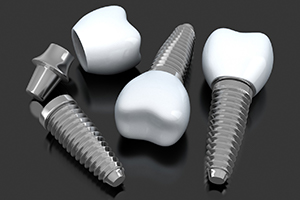
Dental implants are tooth replacements that recreate each part of a missing tooth, from the root hidden beneath the gums to the crown that’s visible in the smile. Each implant consists of a small post made of titanium, which is a biocompatible metal. The implant is surgically embedded in your jawbone, where it fuses to the bone and tissue to essentially become a part of your own anatomy. An abutment just above the gum keeps the post in place. Then, a dental crown, bridge, or denture replaces the visual portion of your teeth. The end result is a tooth replacement that gives you a reason to smile by flawlessly replicating the look, feel, and function of your original teeth!
The 4-Step Dental Implant Process
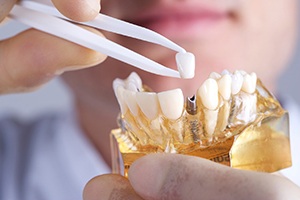
The dental implant process takes course over several months, starting with a consultation with Dr. Sanker. During your initial visit, we’ll determine whether you’re a good candidate for the procedure and put together a detailed timeline so that you know what to expect. Thanks to his advanced training as a prosthodontist, Dr. Sanker can conveniently perform every step of the dental implant treatment process right here in our office! Each patient’s journey looks a little different, but here are the four basic steps of the process:
Initial Dental Implant Consultation

The first step of your dental implant process will be your consultation. During your appointment, Dr. Sanker will take several images of your mouth and facial structure and ask you questions about your overall health and oral habits. This will help him determine whether you’re a good candidate for the procedure. Your consultation is also a good opportunity to get any questions that you have answered.
Working together, we’ll determine the desires you have for your restored smile and discuss any possible limitations with you. If you’re a good candidate for dental implants, we’ll walk you through a step-by-step treatment timeline. Some of our patients need preparatory procedures such as bone grafting, sinus lifts, and periodontal therapy before we can schedule their implant placement, while others can have their implants inserted right away.
Dental Implant Surgery

Dr. Robert J. Sanker is a specialist in prosthodontics and is able to insert your implants from the comfort of our own office. That way, you won’t have to travel between specialists and deal with inconvenient communication gaps. The surgery itself is minimally invasive and virtually pain-free, thanks to sedation and local anesthetic. In fact, many of our patients are able to return to their daily routines the very next day.
Dr. Sanker will make a small incision in your gums and gently insert the implants at strategically planned locations in your jawbone. Once the incisions are closed, you’ll begin your healing and osseointegration process which will take place over the next few months.
Dental Implant Osseointegration/Abutment
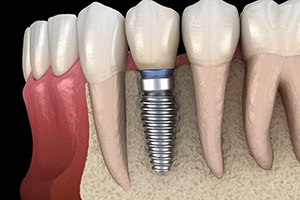
Once your implants have been placed, they will naturally fuse with your jawbone through a process called osseointegration. This is one of the most important parts of the procedure, considering it’s what provides your restorations with a strong and sturdy foundation to be attached to. Once the osseointegration process has finished, we will place your abutments. These are small connector pieces that we attach to your implants to secure your dental crown, bridge, or denture.
Delivery of Dental Implant Restorations
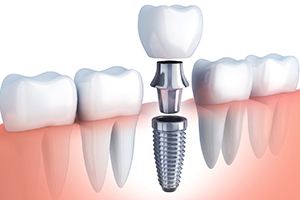
The final and most anticipated part of the process will be your restoration placement. Your implant dentist in Rockville will call you in for your final appointment when we receive your custom-crafted replacement teeth. We’ll check to make sure that they’re created to our specifications and attach them to your abutments, revealing exquisite and natural-looking results.
Once everything is said and done, you’ll be glad to know you invested your time and money into a beautiful, durable, and strong tooth replacement solution that can last over 35 years with the proper care.
Benefits of Dental Implants

If you’ve lost a tooth or two over the years, you have more options than ever to replace your missing teeth. As an alternative to traditional prosthetics, many patients are turning to dental implants to treat their tooth loss. A dental implant is the only solution to recreate the tooth from the root up. This allows you to enjoy a variety of benefits not possible using any other treatment, including:
Predictable Results
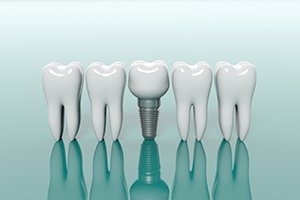
Dental implants produce the most predictable outcome because they offer reliable results. In fact, dental implants have over a 95% success rate. They are proven to last for several decades with the right aftercare, like maintaining your oral hygiene at home and visiting your dentist at least twice a year. This provides a long-term solution that has the potential to pay for itself because it will never need to be replaced.
Looks Natural
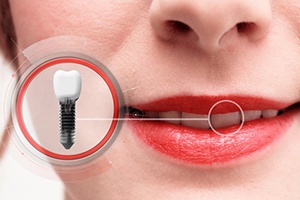
Traditional prosthetics have undergone several improvements in recent years to make them more realistic than ever; however, they will also have their limitations. A dental implant closely looks natural because all-ceramic material is used. This allows it to be carefully crafted to meet your exact size, shape, and color needs to blend in when you smile.
Feels Natural

A dental implant doesn’t rely on other teeth for support. Instead, your jawbone fuses to the titanium post, providing a secure foundation for your restoration. You’ll regain as much as 70% of your natural biting force to enjoy your favorite foods again. This allows you to maintain a complete diet for optimal wellness.
Strengthens the Jawbone

Losing even a single tooth causes you to lose density in your jaw because it isn’t being stimulated by the root. Since traditional prosthetics only recreate the portions of your teeth visible above the surface, they can’t stop bone loss, but a dental implant can. With the post acting as a root, it stimulates your bone to encourage new growth. This keeps your jawbone strong to preserve your natural smile.
Stops Dental Drift
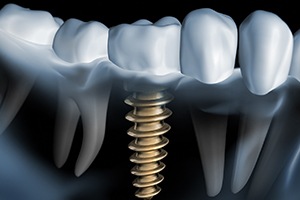
Stopping bone loss gives your remaining teeth the support they need to stay in place. This halts dental drift to prevent alignment issues, cavities, gum disease, and even tooth loss. This allows you to invest in a healthy smile that lowers your long-term cost for care.
Who Dental Implants Can Help
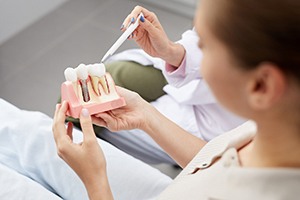
Dental implants in Rockville are the most reliable form of tooth replacement for patients dealing with any level of tooth loss. Whether you’re missing one tooth, several consecutive teeth, multiple teeth throughout your mouth, or an entire arch of teeth, we can create a custom dental implant treatment plan to help you regain the complete smile you deserve. First, we’ll need to see you for a consultation to ensure that you’re a good candidate for dental implants. From there, we can design your treatment plan based on how many teeth you’re missing.
Who Is a Good Candidate for Dental Implants?

Most adult patients with one or more missing teeth qualify for dental implants. To be considered a good candidate, we’ll be looking for three main factors during your consultation:
- Good overall health: Since getting dental implants requires minor surgery, you need to be in good overall health.
- Great oral health: It’s essential for the success of your dental implants that your mouth is free of issues like cavities and gum disease.
- Adequate jawbone density: Dental implants integrate with the jawbone, so you’ll need to have adequate bone density before moving forward with treatment.
If you don’t meet all of these qualifications, we may be able to help you. Many patients need to get preliminary treatments like bone grafting or gum disease treatment before getting their dental implants.
Once you’re cleared as a good candidate for dental implants, we’ll design your treatment plan, including how many dental implants you need, depending on your number of missing teeth.
Missing 1 Tooth
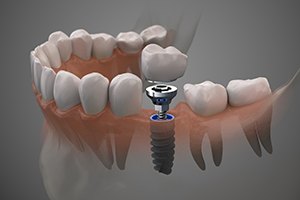
Even if you’re only missing one tooth, it’s critical that it be replaced. Otherwise, the surrounding teeth can begin to shift, which can lead to an imbalanced bite and a greater chance of gum infection. The implant process for replacing a single tooth includes the placement of a single dental implant topped with a custom-made dental crown. The end result will look, feel, and function just like the missing tooth.
Missing Multiple Teeth
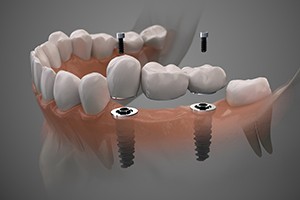
If you have several teeth missing, we can fabricate an implant bridge. Unlike a traditional fixed bridge, the former doesn’t rely on the surrounding teeth to secure it. Instead, several porcelain crowns are attached in a series to a single apparatus that is affixed to the dental implant to provide a durable and lasting restoration. Similarly, for multiple missing teeth around the mouth, we can anchor a partial denture in place with a few dental implants instead of retaining it with metal wires and clasps.
Missing All Teeth
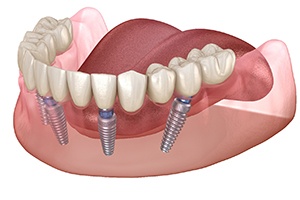
To replace a full set of missing teeth, Dr. Sanker will insert four to six implants per arch. The strategically placed fixtures will be angled in a manner that maximizes the bone-to-implant ratio and supports a complete set of dentures. That means you won’t have to depend on dental adhesive and the natural suction in the mouth to maintain their position. Depending on your unique situation, you may benefit from a traditional implant denture or All-On-4 dental implants.
Understanding the Cost of Dental Implants

We know that a big part of planning for the dental implant procedure is knowing what the cost is. When you visit our office, we’ll perform a thorough examination, which includes assessing how much healthy bone mass remains, the condition of your oral health, and the number of teeth you are missing. Then, for each step of the process, which includes the initial implant placement, the abutment attachment, and the addition of a final restoration, we’ll inform you of the overall price. Read on or reach out to our office to learn more about the cost of dental implants in Rockville.
Preliminary Treatments & Dental Implant Surgery
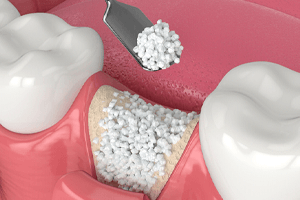
Various factors are involved in the price of dental implants. For example, if you aren’t already a good candidate for the procedure, then you might require preliminary treatments like bone grafting or gum disease therapy. While these may be necessary to ensure the success of your implants, they will add to the overall price.
The dental implant surgery itself can also impact how much you’ll pay. This may involve where your restorations will be placed in your mouth and even the type of sedation dentistry you’ll undergo. Fortunately, our team can perform the entire treatment in-office, which can help save you time, money, and trouble from having to visit an outside specialist.
The Parts of Your Dental Implant
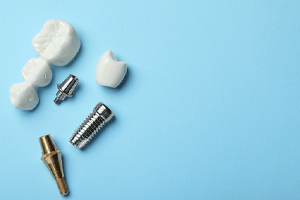
The price of your treatment can also be influenced by the parts of the dental implants themselves, including:
- Type of restoration – Dental implants can support custom-crafted restorations like crowns, bridges, and dentures that have unique price ranges.
- Number of implants – The more titanium posts you require to restore your smile, the higher the cost of your procedure.
- Material and size – Implants come in various lengths and sizes, and they can also be constructed out of different materials, such as zirconia and titanium. These details can alter the price of your treatment.
- Brand of implants – Different companies manufacture dental implants, each offering its specific price points. Our team works only with the highest-quality brands to ensure you receive the best results for your smile.
How Dental Implants Can Save You Money

Although dental implants do come with a hefty one-time cost, they will likely save you much more in the long term. Dental bridges and dentures typically have a more affordable upfront value, but you’ll need to get them adjusted or replaced every few years. This can stack up on the overall price, especially if you need cleansing solutions and adhesives. With dental implants, however, you can be sure to enjoy them for several decades (or even a lifetime) with proper care. This can save you thousands of dollars, and you’ll only need to practice good oral hygiene and schedule checkups with your dentist routinely to maintain them. Plus, with the boost in your confidence and quality of life, your dental implants will certainly pay for themselves.
Does My Dental Insurance Cover Dental Implants?

Dental insurance won’t typically cover the entire dental implant procedure. Depending on the policy, you might expect to receive coverage for parts or a percentage of your treatment. These may include the initial consultation, any preliminary treatments, and restorations. That’s why you’ll want to double-check the details of your insurance plan with your provider before beginning any work. You can also consult our knowledgeable staff, as we’ll be more than happy to help you navigate your policy and maximize your benefits.
Making Dental Implants Affordable

Don’t currently have dental insurance? There’s no need to worry. We understand the importance of being able to pay for the restorations you need to regain your complete and beautiful smile. That’s why we’re proud to offer alternative financing options, like CareCredit. This third-party financier can help break up the overall price of your treatments into smaller monthly installments. These plans also come with little to no interest, meaning you can save more in the bank while renewing your missing pearly whites!
Advanced Dental Implant Procedures
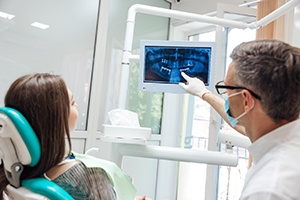
Most people who have good oral and general health are candidates for dental implants; however, some patients will require additional procedures before undergoing their placement surgery. If you’ve lost density in your jaw, you might need bone grafting to create a stable foundation for your new smile. If you’ve lost bone in the back of your mouth near your molars, a sinus augmentation may also be needed. Although they add additional steps to your treatment plan, they are essential to ensure your new smile has everything it needs to thrive.
Bone Grafting
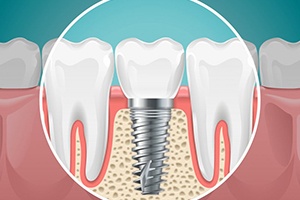
A titanium implant post is surgically placed into your jawbone to act as a new root. You must have adequate bone density for your jaw to support the post. If you’ve had missing teeth for several years or suffered from advanced gum disease, your jawbone might be compromised. Don’t worry, we can enhance the thickness of areas that have weakened using bone grafting.
The surgical procedure takes bone from another area in your mouth or from a donor and transfers it to the treatment site using a surgical procedure. Over the next several months, your jaw will integrate with the graft to ensure that it’s strong enough to support the posts in the long term.
Sinus Lifts
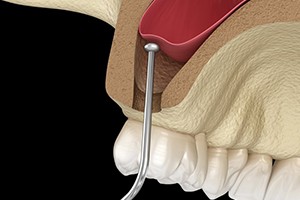
Also known as a sinus augmentation, this treatment is needed when there isn’t enough bone near the back molars in the upper arch. If implant posts are placed into the bone, the posts can protrude into the maxillary sinuses, which are located on either side of your nose. A sinus lift raises the sinuses and adds bone to ensure there is enough space for the implant posts.
During the surgical procedure, a small oval is cut into your bone and the sinus is lifted upward. A bone graft is placed into the hole and your gum tissue is sutured closed. Over the next several weeks, your jawbone will heal, making you a suitable candidate for dental implants.
Dental Implants Post-Op Instructions

A successful recovery period is crucial for ensuring the long-term success of your dental implants. Our team will let you know what will happen during the recovery process and explain what steps you will need to take in order to avoid problems. Listed below are some general guidelines that you should keep in mind after your dental implants have been placed. If you have any questions about the instructions you’ve received, don’t hesitate to reach out to us.
What to Do Directly After Dental Implant Surgery

Obviously, you will need to spend some time resting at home after your dental implant surgery. While you’re taking it easy, you need to make sure that you are protecting the blood clot at the site where the surgery was performed. The blood clot needs to stay in place to ensure that the gums can heal correctly. Spitting, drinking through a straw, and smoking can all dislodge the blood clot, so avoid these actions entirely in the days following your procedure.
Common Side Effects When Recovering from Dental Implant Placement

There are a few side effects that might occur after you receive dental implants. There may be some soreness that can be relieved with medication (which may or may not be prescribed depending on your circumstances). You might also experience some swelling, in which case we suggest holding a cold compress over the area. If there’s any bleeding, press down on it with gauze until it stops. Remember that you can always call us if your symptoms seem unusually severe.
Your Diet After Dental Implant Surgery

It’s best to stay away from solid foods for a while once dental implants have been placed. You will be able to return to a normal diet with time, but until then, you should focus on eating soft foods like mashed potatoes, scrambled eggs, pasta, and yogurt. You can also have various soups and broths, but remember that you shouldn’t eat anything too hot. (The implant site may become irritated if it is exposed to high temperatures.)
Post-Op Health & Oral Hygiene

You don’t want any harmful bacteria to get in the way of the healing process, so make a point of keeping your mouth as clean as possible in the days following your dental implant surgery. You should be able to brush the way you normally would, although you will need to be particularly gentle around the implant posts. We suggest rinsing with salt water or a prescription mouthwash whenever you finish eating. Keep in mind that if you do use mouthwash, you should make sure that it doesn’t contain any alcohol.
What to Do After Your New Teeth Are Attached

Once your dental implants have formed a strong bond with your jaw, the final restoration can be attached. Compared to dental implant placement, this is a relatively simple process. At most, your gums may be mildly sensitive afterwards. Let us know right away if there is any swelling or bleeding, as these are not normal side effects at this stage.
Maintaining & Caring for Your Dental Implants

Dental implants stay permanently anchored to your jaw at all times. As such, taking care of them is not much different than taking care of your natural teeth; many of the steps you will have to follow are the same. Of course, if you want your dental implants to last as long as possible, you need to be especially diligent about maintaining them properly. Below is a brief guide covering what you should do to keep your new smile safe.
Make Oral Hygiene a Priority

Naturally, even after receiving dental implants, you will still need to brush and floss any natural teeth remaining in your mouth. But don’t neglect your dental implants in the process; they may not be susceptible to cavities, but they could fail if the tissues holding them in place become infected. As such, you need to make a point of cleaning your dental implants thoroughly during your regular oral hygiene routine. Remember that you need to brush at least two times a day and floss at least once a day.
Eat a Healthy Diet

Overindulging in sugary or starchy foods can increase your risk for gum disease, which could cause serious problems for your smile. It’s therefore best to cut down on sweets and chips as much as you can while eating more foods that promote oral health. In particular, you will want to focus on fruits and vegetables that contain vitamin C, which is essential for strong gums.
Break Bad Habits

Do you ever find yourself absent-mindedly chewing on your fingernails? This is a prime example of a bad habit that could end up damaging your dental implants if you’re not careful. Other habits that are less than ideal for your new teeth include smoking, biting the end of your pen, opening packages with your teeth, and crunching ice. Take the time to identify behaviors that are bad for dental implants and create a strategy to give them up before they can lead to any truly serious issues.
Protect Your Dental Implants
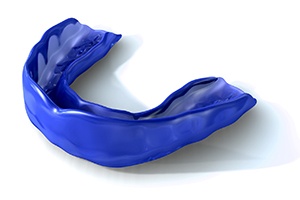
If you get hit in the mouth while playing your favorite sport, you may end up with broken dental implant posts. It pays to be prepared for the worst, so make sure that you always wear a mouthguard when engaging in any sort of athletic activity. It may also be a good idea to invest in a nightguard to wear while you’re asleep; that way, if you grind or clench your teeth during the night, your dental implants (and the rest of your smile) will be well-protected.
Schedule Regular Dental Checkups

During a routine checkup and cleaning, your regular dentist can check your dental implants to make sure they’re in good shape. If there are any problems developing, they can let you know right away; this will allow you to quickly take whatever steps are necessary to protect your smile.
Dental Implant FAQs

Do you still have questions about the details of the dental implant process? We’ve answered a few frequently asked questions below! To learn more about the dental implant procedure and to finally experience the joys of having your smile completely restored, contact us today to request an appointment !
How Are Dental Implants Placed?
After the anesthetic has numbed the site, a small incision is made in your gums. Then, the implant is placed in your jaw. A protective cap covers the implant to shield it during osseointegration—when the implant and surrounding bone fuse together. The cap also maintains the shape of your gum tissue, which makes attaching replacement teeth easier.
Does Dental Implant Surgery Hurt?
No, not at all. Dr. Sanker administers a local anesthetic to the site before he begins the procedure. You may feel pressure as he works, but you will not feel any pain.
What Is Recovery Like After Dental Implant Surgery?
If you only need one dental implant, then you will likely feel up to doing your normal daily activities after your appointment. However, if you are receiving more than one implant, then you may need a day or two to rest. While you recover, be sure to drink plenty of fluids, eat soft foods and brush gently around the surgical site.
How Long Do I Have to Wait for My New Teeth?
That all depends on how many dental implants you’ve received. For one implant, the healing time usually takes between three to six months. Healing after surgery for several implants may take longer.
How Successful Are Dental Implants?
Dental implants are more than 95 percent successful. Furthermore, research shows that implants are very safe. Risk factors such as smoking, poor oral hygiene, diabetes or another disease that can impede healing could increase the chance of failure.
How Long Do Dental Implants Last?
This all depends on the patient’s lifestyle and health. To ensure that dental implants last, it is important to brush, floss, and rinse with a mouthwash every single day. Always attend your routine cleanings and checkups. It is also a good idea to avoid foods that are particularly hard or sticky. With proper maintenance, dental implants can last upwards of three decades. This is several times longer than traditional bridges and dentures.
Can I Get Dental Implants If I’m Diabetic?
If your diabetes is under control, your odds of dental implant success are comparable to those of nondiabetic patients. Uncontrolled diabetes and chronic high blood sugar can slow down the healing process, making it more difficult for your implants to integrate with the jawbone. If you are interest in getting dental implants but you have diabetes, talk to your endocrinologist or primary care physician about getting your diabetes under control ahead of time.
Do Dental Implants Make You Look Younger?
Yes! The force of biting and chewing spreads through the roots of your teeth to stimulate your jawbone. When a tooth is missing, the jawbone loses that stimulation and begins to deteriorate. Since the jawbone can no longer support the facial structures, you may end up with sunken-in cheeks and fine lines around the mouth. Dental implants are the only tooth replacement option that replaces the roots of the missing teeth and stimulate the jawbone. Ultimately, they will help you to keep your youthful appearance.
Do I Need a Bone Graft Before Getting Dental Implants?
Bone grafting involves transplanting a piece of bone tissue to the jawbone to strengthen it so that it can accommodate dental implants. The jawbone often atrophies after teeth have been lost because the tooth’s roots no longer stimulate It through biting and chewing. Detailed scans of your jaw area will be taken to determine whether or not you will need bone grafting before getting dental implants.
Are Dental Implants Right for Me?
Chances are the answer to this question is yes! Schedule a consultation with Dr. Sanker to find out if dental implants can restore your beautiful smile.
